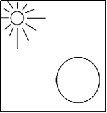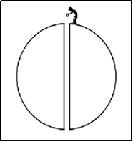This focus idea is explored through:
Contrasting student and scientific views
Student everyday experiences
 Gravity as well as electrostatic and magnetic attraction and repulsion provide real life examples of forces being exerted by one object on another without them being in contact with each other. Many children are aware of magnetism and have played with fridge magnets. They may also have played with picking up small pieces of paper or other objects with a comb charged by rubbing against the sleeve of a jumper or by pulling through hair. They will also be aware that things fall towards the Earth. However, they are unlikely to think about these experiences as involving forces, i.e. pushes and pulls.
Gravity as well as electrostatic and magnetic attraction and repulsion provide real life examples of forces being exerted by one object on another without them being in contact with each other. Many children are aware of magnetism and have played with fridge magnets. They may also have played with picking up small pieces of paper or other objects with a comb charged by rubbing against the sleeve of a jumper or by pulling through hair. They will also be aware that things fall towards the Earth. However, they are unlikely to think about these experiences as involving forces, i.e. pushes and pulls.
It is common for students to think that all metals are attracted by magnets, and that the size of magnets determines their strength.
Research: Fleer, Jane & Hardy (2007)
A common understanding in everyday life that dates back to ancient times is the belief that things fall towards the Earth because it is ‘natural’. Some students may use the word ‘gravity’ in this non scientific sense, i.e. without recognising that gravity involves objects experiencing a force that pulls them towards the centre of the Earth.
Students’ ideas about gravity are often linked to their ideas about the shape of the Earth and about the direction of ‘down’. Students may appear to think the Earth is a sphere but nevertheless consider, for example, that people live on a flat place either on top of the sphere or inside it.
Research: Nussbaum (1985)
This idea is also explored in the focus idea
Day and night.
Some students think gravity only affects heavy objects. They don’t link weight to gravity.
This idea is also explored in the focus idea
Gravity.
Scientific view
Scientists use the construct of a ‘field’ to explain how one object can affect another without touching it, even without any substance in between. There are three examples of such fields that we experience in everyday life:
- A magnet is surrounded by a magnetic field which pushes or pulls other magnets and things made of iron, nickel or cobalt that are located within it. (Because its interior acts like a magnet, the Earth is surrounded by a magnetic field that affects things made of magnetic material, such as compasses).
- A charged object is surrounded by an electric field which exerts electrical forces on other things within the field.
- The Earth is surrounded by a gravitational field that pulls all other objects towards its centre.
Unlike the other two fields, which can involve both attraction and repulsion, gravity only acts by attraction. All objects attract each other by gravity, but these attractions are too weak to notice unless one object contains a huge amount of matter (stuff).
Critical teaching ideas
- Some objects experience forces from things that are not touching them.
- Magnets can be used to make other magnets and things made of iron move without being touched.
- Something that has been electrically charged can make other things move without touching them.
- Things near the Earth fall toward the Earth unless something holds them up. The Earth pulls any object towards the centre of the Earth without touching it

Explore the relationships between ideas about forces without contact in the
Concept Development Maps –Gravity
Students should be encouraged to explore the effects of magnetic and electric forces. The main notion to convey here is that forces can act at a distance with no perceivable substance in between.
Through their investigations, students can show magnets do not affect all metals but can push or pull other magnets and things made of iron (and steel). Part of their investigations should involve compasses, which are magnets that are affected by the magnetic forces from inside the Earth, and magnets of different sizes.
Students should also explore what types of materials can be charged by rubbing, and what types of materials are affected by charged objects.
The idea that the Earth pulls on objects is difficult for many students. Research suggests that it is helpful to spend some time helping students to understand that the Earth is a sphere and that objects falling ‘down’ are falling ‘towards the centre of the Earth’.
‘Gravity’ is not a
thing but a description for a type of interaction between objects. Referring to the pull of the Earth as the ‘gravity force’ of the Earth, rather than just ‘gravity’ helps to promote student understanding that the force comes from the Earth, and is not a thing called ‘gravity’.
Research: Gunstone, Mulhall & McKittrick (2007)
A useful analogy for explaining the Earth’s gravity force is that the Earth can pull on objects without touching them just like a magnet can affect other objects without touching them.
Teaching activities
Students should carry out investigations to explore the idea that objects can experience forces from things that are not touching them.
Provide an open problem to be explored through play
 Students can explore the effects of magnets and charged objects on different kinds of objects. They can observe the differing effects of the north and south poles of a magnet on the poles of other magnets, and investigate whether the magnet’s size affects magnetic strength.
Students can explore the effects of magnets and charged objects on different kinds of objects. They can observe the differing effects of the north and south poles of a magnet on the poles of other magnets, and investigate whether the magnet’s size affects magnetic strength.
Focus students’ attention on overlooked detail
Students will often have had experiences with magnets and charged objects, and plenty of experiences involving gravity, but generally will not have linked these experiences to the forces involved. They need to observe the changes in motion of things brought about by magnets and charged objects such as plastic pens, and explore the effects of magnets.
Bring out students’ existing ideas
A questionnaire on students’ ideas about the Earth and gravity can expose the range of views in the class. This can be a useful way of promoting discussion and debate, as well as helping to shape further teaching.
Promote reflection on existing ideas
Discussion about the forces on a stationary book sitting on a table, can lead to an understanding that the supporting force of the table on the book is balanced by a force downwards coming from the Earth. By considering the same book as it topples from the edge of the table, discussion can now focus on the gravity force of the Earth pulling the book downwards. See the focus idea:
Forces on stationary objects.
Bring out students’ existing ideas
Consider using questions like the ones below to probe your students’ alternate conceptions.
| Bring out students’ existing ideas |
|---|
Question One - Why is the Earth flat in picture one and round in picture two? a) They are different Earths
b) The Earth is round like a ball but people live in the flat parts in the middle
c) The Earth is round like a ball but it has flat spots on it
d) The Earth is round like a ball but looks flat because we see only a small part of the huge ball
e) The Earth is round like a plate or CD so it seems round when you’re over it and flat when you are on it. |

 |
Question Two – Pretend that the Earth is made of glass and you can look straight through it. Which way would you look in a straight line to see people in far off countries like China or India? |
 |
Question Three – This drawing shows some vastly enlarged people dropping rocks at various places around the Earth’s surface. Show what happens to each rock by drawing a line showing the complete path of the rock, from the person’s hand to where it finally stops. |

|
Question Four – Pretend that a tunnel was dug all the way through the Earth, from the North Pole to the South Pole. Imagine that a person holds a rock above the opening at the North Pole and drops it. Draw a line showing the entire path of the rock. |

|
Research: Sneider and Ohadi (1998)